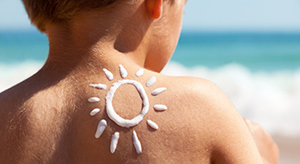The invisible damage: more than just sunburn

The power of the sun is good for you, but its rays can also be harmful. An expert from the Medical Center - University of Freiburg, Dr. Frank Meiß, explains the hidden risks of sun exposure and how proper sun protection can protect our skin and keep it healthy.
"A sunburn may pass, but the skin never forgets its consequences," says Dr. Frank Meiß from the Department of Dermatology. Simply said, the effect of the sun on the skin consists of two patterns of damage, according to the expert.
Number one is sunburn. It usually manifests itself as reddened skin, blistering and pain. This pattern of damage, particularly in childhood and adolescence, is a major risk factor for the development of black skin cancer, melanoma.
The second pattern of damage is recurring, cumulative damage, similar to a ‘sun account‘. With too much sun exposure, healthy cells can mutate into cancer cells even without sunburn. "If the ‘sun account‘ is full at some point," Dr. Meiß says, "the risk of white skin cancer increases."
Different skin types: Sun protection applies to everyone
Sensitivity to the sun varies greatly depending on skin type. Dr. Meiß advises people with fair skin types in particular to exercise caution. They have less natural protection against UV rays and are therefore more susceptible to sunburn and long-term damage. But people with darker skin that tans quickly should also be careful not to go out in the sun unprotected.
The right protection: rules of thumb for sun-seekers
To protect yourself from the dangers of UV rays, sun protection products are the first choice in addition to appropriate clothing and avoiding the midday sun (between 11 AM and 3 PM). The expert recommends choosing products with a high sun protection factor (SPF) – the the higher the better. A fair skin type that has just five to ten minutes of self-protection of the skin and uses a sunscreen with SPF 50 has a fifty-fold increase in self-protection until sunburn occurs. However, UV damage to the skin also occurs before a visible and noticeable sunburn. It is therefore important to expose yourself to the sun in moderation even with sun protection products applied, and to apply sufficient sun cream. Dr. Meiß also points out that this protection can also be reduced by external influences and recommends "reapplying sunscreen after every bath, shower or drying off".
Six tablespoons of sunscreen for the whole body
So how do you know how much sunscreen your body needs? There is a rule of thumb for this too: the expert advises 40 heaped fingertips every time you apply sunscreen, which corresponds to six tablespoons of sunscreen for the whole body.
Early detection saves lives: When to see a doctor?
It's important to pay close attention to changes in the skin, as early signs of white skin cancer can often be identified by the appearance of reddish bumps on the face. Some of these bumps may have a broken surface, and the affected area may ooze or bleed. White skin cancer typically appears on the so-called "sun terraces" of the face, which include the bridge of the nose, the forehead, the back of the hands, and the scalp.
The ABCDE rule can help identify skin changes that may indicate black skin cancer. The abbreviation stands for Asymmetry, Border, Color, Diameter, and Evolution/Elevation.
Warning signs of melanoma include:
- an asymmetrical pigmented mole,
- irregular or blurred edges,
- different colors,
- a diameter of more than five millimeters, and
- any changes or elevation in the mole's appearance.
If one or more criteria apply, a doctor should be consulted.
Dr. Meiß appeals to the responsibility of each individual: "Take the initiative for your health, go for regular skin cancer screenings and pay attention to changes in your skin. If detected early, skin cancer can often be treated well."
Back